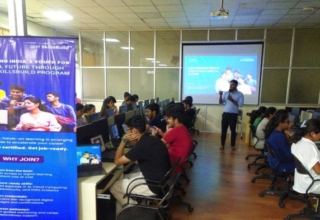
By Arun Prakash, Founder & CEO of GUVI
India’s role in furthering STEM education among women has received global applause, as the country has recorded 43% enrollment by women in relevant courses. This enhanced figure has not only underlined a societal shift but also highlights the growing interest of women to compete in a historically male-dominated industry. This has also substantially increased India’s potential workforce, and has made women a meaningful contributor to the national economy.
The growing emphasis on technology globally is renewing the interest in STEM (Science, Technology, Engineering & Mathematics) education. It is being considered as one of the critical enablers of garnering viable and holistic growth — personally and professionally, while also supplementing the development of the modern world. Educationists and industry leaders are highlighting equal accessibility and participation of women in STEM, a notion that has been echoed in the United Nation’s 2030 Agenda for Sustainable Development Goals (SDGs). The Government of India therefore is rightly extending critical support to enhance the participation of women in STEM, which has been highlighted by some encouraging announcements the Union Budget in 2024.
The Indian government has also adopted a proactive approach to supplement this aspect nationally. This was echoed in the last Union Budget when Union Minister of Finance Nirmala Sitharaman revealed that 30 lakh Mudra Yojana loans have been disbursed in the last 10 years — helping beneficiaries with a significant amount of INR 22.5 Lakh Crore. Apart from this, the recent budget also allocated a financial package worth INR 1.48 lakh crore.
Supportive policies
Apart from the United Nations, governmental forums and initiatives and other stakeholders have introduced several policies to enhance women’s participation in STEM — beginning from the Beijing Declaration by the UN. In India, the STI Policy (Science, Technology and Innovation) of 2013 have been a critical factor in promoting gender equality in relevant activities. Coupled with this, the Women in Science and Engineering-KIRAN (WISE-KIRAN) and the Women Scientist Scheme have been particularly beneficial in helping promote women’s participation in STEM and sustain their careers, empowering them to become the critical enabler of India’s future.
In recent times, different Indian Institutions of Technology (IITs) have introduced initiatives to increase women enrollment, whereas the All India Council for Technical Education (AICTE) has made inroads in the domain through its two schemes – the Pragati Scholarship and the TechSaksham Programme that are designed to increase women’s employability in diverse sectors. The Vigyan Jyoti programme has been a significant enabler of rural girls to pursue STEM education in both higher secondary and graduation levels – underlining the robust emphasis of the government to ensure a comprehensive effort to raise women’s participation in STEM and related sectors.
As efforts on the national and international levels look to enhance women’s participation in STEM education and beyond, it is only a matter of time before India and the rest of the world will begin reaping the rewards. The long-term objective of this push is to raise the overall efficiency of the global workforce while infusing fresh ideas to ensure continued technological evolution that will sustain the world for years to come. Women empowerment has already been identified as an era-appropriate issue, and the subsequent efforts are paving the way for a more productive and holistic worldview.
Conclusion
India boasts the largest population of STEM graduates globally, and this development has only been rising in the last two decades. Indian women also publish more research papers on STEM subjects than comparable low-income countries, leading to the nation setting a new benchmark. However, a large number of Indian women working in STEM sectors also drop out of their careers owing to numerous challenges, an obstacle that the industry is looking to address productively. In fact, the Global Gender Gap Report of 2023 reveals that only 29.2% of employees in STEM sectors in 146 countries are women, whereas almost half of the total workforce (49.3%) in non-STEM sectors are women.
So, the efforts in spreading STEM education must continue while looking ways to encourage them to enter the technology workforce and importantly progress there.









